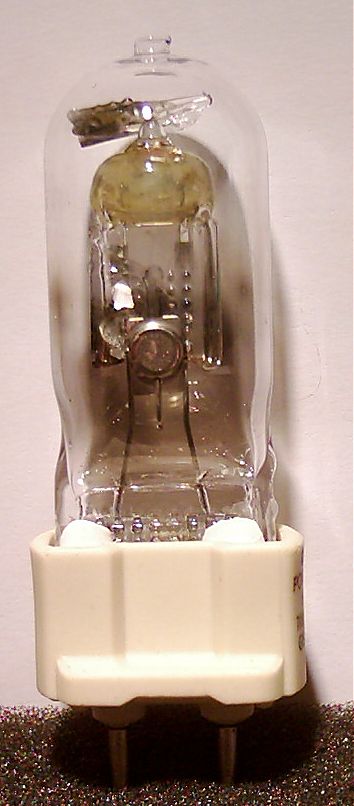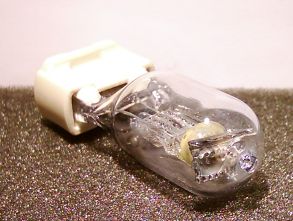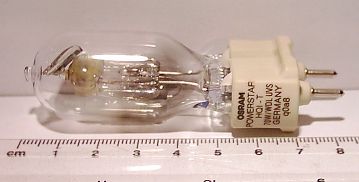
| Manufacturer: | Osram |
| Model: | Powerstar HQI-T 70W/WDL/UVS Warmweiss De Luxe |
| Application: | Industrial High CRI lighting |
| Wattage: | 70W |
| Diameter (max): | 23mm |
| Length: | 85mm |
| Arc Length: | 5mm electrode gap |
| Bulb/Tube material: | Inner: Quartz. Outer: UV-Stop Quartz |
| Colour Temperature: | 3000K |
| Colour Rendering Index: | 80 |
| Peak output wavelength: | Broadband |
| Total light output: | 5,200 Lumens - 74.3 Lm/W |
| Rated lifetime: | 6,000 Hours |
| Cap: | G12 |
| Operating voltage: | 90V AC |
| Operating current: | 0.98A |
| Warmup/restrike time: | 3 Minutes/approx 5-15 minutes dependant on ballast type |
| Cost (original): | Unknown |
| Place of manufacture: | Germany |
| Date of manufacture: | Not known, code q0a8 shown on lamp cap |
| Lamp Status: | Destroyed by faulty ballast |
Metal halide lamps are an almost direct evolution of the high pressure mercury vapour lamp - this is more clear to see with quartz version such as this than with the versions making use of a ceramic arc tube, which appear substantially different. The first commercial lamps making use of trace amounts of metal halide salts in addition to the raw mercury vapour inside the arc tube to fill out otherwise troublesome gaps in the discharge spectra can be traced back to the 1960s.
This lamp is pretty typical of many modern lamps of its style, with a single ended quartz capsule sealed within a vacuum outer jacket. The presence of only one pinch seal on the arc tube helps to keep manufacturing costs as low as possible.
The outer jacket of this lamp is manufactured of UV-stop quartz, this is a great help to the designers of luminaries, as the high UV output from these lamps otherwise could potentially result in rapid discolouration of plastic reflectors or lenses.
Though the UV output is kept to a minimum - it is still imperative that a lamp such as this never be operated outside a purpose built, fully enclosed fixture. This is due to the fact that if the lamp is operated beyond its rated lifetime, that it could explode. This is due to the high internal operating pressure in conjunction to the corrosive nature of hot halide salts to the arc tube. Fixtures for these lamps will be designed specifically to contain the high speed fragments of red hot quartz should an arc tube rupture ever occur.
The lamp pictured here unfortunately met its end due to either a faulty igniter or a faulty ballast - precisely which failed initially I don't know, and probably never will - it ended up with them both being fried however...You can see the high current which was passed through the lamp has blown one of the foil seals in this case open circuit.

Osram Powerstar HQI-T 70W/WDL/UVS Warmweiss De Luxe Quartz Metal Halide Lamp - General overview

Osram Powerstar HQI-T 70W/WDL/UVS Warmweiss De Luxe Quartz Metal Halide Lamp - Showing internal layout more clearly

Osram Powerstar HQI-T 70W/WDL/UVS Warmweiss De Luxe Quartz Metal Halide Lamp - Looking down towards crown of lamp

Osram Powerstar HQI-T 70W/WDL/UVS Warmweiss De Luxe Quartz Metal Halide Lamp - Showing size of lamp
Many thanks to a website visitor who contacted me to fill in many of the gaps in the data for this lamp and to the other visitor who donated it along with many others.
This page last updated:
18th June 2023: Changes to page formatting to improve readability on mobile devices. Also some background code changes to improve search engine behaviour.
This is actually one of the first lamps that was ever added here, as such I can only apologise for the quality (or rather the lack thereof) in the photos. If I come across this or an identical lamp at some point in the future I will re-shoot the photos and update them if I can.